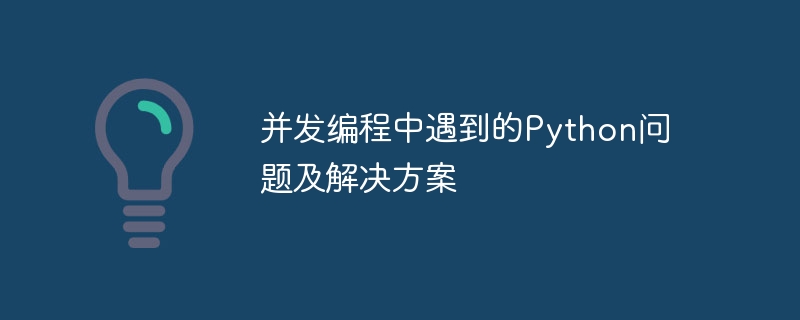並發程式設計中遇到的Python問題及解決方案

標題:並發程式設計中遇到的Python問題及解決方案
引言:
在現代電腦系統中,利用並發程式設計可以充分發揮多核心處理器的性能,提高程式的運作效率。 Python作為一種廣泛使用的程式語言,也具備了強大的並發程式設計能力。然而,在並發程式設計中常常會遇到一些問題,本文將介紹一些並發程式設計中常見的Python問題,並提供對應的解決方案,並附有具體的程式碼範例。
一、全域解釋器鎖定(GIL)
- 問題概述:
在Python中,全域解釋器鎖定(Global Interpreter Lock,簡稱GIL)是一種對多執行緒運行的Python程式的限制。 GIL導致在多核心處理器上並發程式無法真正並行執行,從而影響了Python並發程式的效能。 - 解決方案:
(1)使用多進程取代多線程,在多個進程之間實現真正的並行執行。
(2)使用Cython等工具,透過編寫C擴充模組來繞過GIL的限制。
範例程式碼:
import multiprocessing
def compute(num):
result = num * 2
return result
if __name__ == '__main__':
pool = multiprocessing.Pool()
numbers = [1, 2, 3, 4, 5]
results = pool.map(compute, numbers)
print(results)二、執行緒安全性
- #問題概述:
多執行緒環境下,多個執行緒同時存取共享資源時可能會引發資料競爭(data race)等執行緒安全性問題,導致程式出錯。 - 解決方案:
(1)使用互斥鎖(Mutex)來確保同一時間只有一個執行緒能夠存取共享資源。
(2)使用線程安全的資料結構,如threading模組中的Queue隊列。
範例程式碼:
import threading
import time
class Counter:
def __init__(self):
self.value = 0
self.lock = threading.Lock()
def increment(self):
with self.lock:
old_value = self.value
time.sleep(1) # 模拟耗时操作
self.value = old_value + 1
if __name__ == '__main__':
counter = Counter()
threads = []
for _ in range(5):
t = threading.Thread(target=counter.increment)
threads.append(t)
t.start()
for t in threads:
t.join()
print(counter.value)三、並發資料共享
- #問題概述:
在多執行緒或多進程程式中,資料的共享是非常常見的需求,但同時也帶來了資料一致性和競爭條件(race condition)等問題。 - 解決方案:
(1)使用執行緒安全的資料結構,如threading模組中的Queue佇列來協調不同執行緒/進程之間的資料共享。
(2)使用進程間通訊(Inter-process Communication,IPC)機制,如佇列、管道等。
範例程式碼:
import multiprocessing
def consumer(queue):
while True:
item = queue.get()
if item == 'end':
break
print(f'consume {item}')
def producer(queue):
for i in range(5):
print(f'produce {i}')
queue.put(i)
queue.put('end')
if __name__ == '__main__':
queue = multiprocessing.Queue()
p1 = multiprocessing.Process(target=consumer, args=(queue,))
p2 = multiprocessing.Process(target=producer, args=(queue,))
p1.start()
p2.start()
p1.join()
p2.join()結論:
本文透過對並發程式設計中常見的Python問題進行分析,提供了相應的解決方案,並附有具體的程式碼範例。並發程式設計是提高程式運作效率的重要手段,合理解決並發程式設計中的問題,將會大大提升程式的並發能力和效能。
以上是並發程式設計中遇到的Python問題及解決方案的詳細內容。更多資訊請關注PHP中文網其他相關文章!

熱AI工具

Undresser.AI Undress
人工智慧驅動的應用程序,用於創建逼真的裸體照片

AI Clothes Remover
用於從照片中去除衣服的線上人工智慧工具。

Undress AI Tool
免費脫衣圖片

Clothoff.io
AI脫衣器

Video Face Swap
使用我們完全免費的人工智慧換臉工具,輕鬆在任何影片中換臉!

熱門文章

熱工具

記事本++7.3.1
好用且免費的程式碼編輯器

SublimeText3漢化版
中文版,非常好用

禪工作室 13.0.1
強大的PHP整合開發環境

Dreamweaver CS6
視覺化網頁開發工具

SublimeText3 Mac版
神級程式碼編輯軟體(SublimeText3)
 使用C++實現機器學習演算法:常見挑戰及解決方案
Jun 03, 2024 pm 01:25 PM
使用C++實現機器學習演算法:常見挑戰及解決方案
Jun 03, 2024 pm 01:25 PM
C++中機器學習演算法面臨的常見挑戰包括記憶體管理、多執行緒、效能最佳化和可維護性。解決方案包括使用智慧指標、現代線程庫、SIMD指令和第三方庫,並遵循程式碼風格指南和使用自動化工具。實作案例展示如何利用Eigen函式庫實現線性迴歸演算法,有效地管理記憶體和使用高效能矩陣操作。
 C++ 並發程式設計中資料結構的同時安全設計?
Jun 05, 2024 am 11:00 AM
C++ 並發程式設計中資料結構的同時安全設計?
Jun 05, 2024 am 11:00 AM
在C++並發程式設計中,資料結構的並發安全設計至關重要:臨界區:使用互斥鎖建立程式碼區塊,僅允許一個執行緒同時執行。讀寫鎖:允許多個執行緒同時讀取,但只有一個執行緒同時寫入。無鎖資料結構:使用原子操作實現並發安全,無需鎖。實戰案例:執行緒安全的佇列:使用臨界區保護佇列操作,實現執行緒安全性。
 C++ 函式在並發程式設計中的事件驅動機制?
Apr 26, 2024 pm 02:15 PM
C++ 函式在並發程式設計中的事件驅動機制?
Apr 26, 2024 pm 02:15 PM
並發程式設計中的事件驅動機制透過在事件發生時執行回呼函數來回應外部事件。在C++中,事件驅動機制可用函數指標實作:函數指標可以註冊回呼函數,在事件發生時執行。 lambda表達式也可以實現事件回調,允許建立匿名函數物件。實戰案例使用函數指標實作GUI按鈕點擊事件,在事件發生時呼叫回呼函數並列印訊息。
 C++並發程式設計:如何進行任務排程和執行緒池管理?
May 06, 2024 am 10:15 AM
C++並發程式設計:如何進行任務排程和執行緒池管理?
May 06, 2024 am 10:15 AM
任務調度和執行緒池管理是C++並發程式設計中提高效率和可擴充性的關鍵。任務調度:使用std::thread建立新執行緒。使用join()方法加入執行緒。執行緒池管理:建立ThreadPool對象,指定執行緒數量。使用add_task()方法新增任務。呼叫join()或stop()方法關閉執行緒池。
 C++ 並發程式設計中的同步原語詳解
May 31, 2024 pm 10:01 PM
C++ 並發程式設計中的同步原語詳解
May 31, 2024 pm 10:01 PM
在C++多執行緒程式設計中,同步原語的作用是保證多個執行緒存取共享資源時的正確性,它包括:互斥鎖(Mutex):保護共享資源,防止同時存取;條件變數(ConditionVariable):執行緒等待特定條件滿足才繼續執行;原子操作:保證操作以不可中斷的方式執行。
 C++並發程式設計:如何處理線程間通訊?
May 04, 2024 pm 12:45 PM
C++並發程式設計:如何處理線程間通訊?
May 04, 2024 pm 12:45 PM
C++中執行緒間通訊的方法包括:共享記憶體、同步機制(互斥鎖、條件變數)、管道、訊息佇列。例如,使用互斥鎖保護共享計數器:聲明互斥鎖(m)、共享變數(counter);每個執行緒透過加鎖(lock_guard)更新計數器;確保一次只有一個執行緒更新計數器,防止競爭條件。
 C++並發程式設計:如何避免執行緒飢餓和優先反轉?
May 06, 2024 pm 05:27 PM
C++並發程式設計:如何避免執行緒飢餓和優先反轉?
May 06, 2024 pm 05:27 PM
為避免執行緒飢餓,可以使用公平鎖確保資源公平分配,或設定執行緒優先權。為解決優先權反轉,可使用優先權繼承,即暫時提高持有資源執行緒的優先權;或使用鎖的提升,即提升需要資源執行緒的優先權。
 C++ 中有哪些並發程式框架和函式庫?它們各自的優點和限制是什麼?
May 07, 2024 pm 02:06 PM
C++ 中有哪些並發程式框架和函式庫?它們各自的優點和限制是什麼?
May 07, 2024 pm 02:06 PM
C++並發程式框架具有以下選項:輕量級執行緒(std::thread);執行緒安全的Boost並發容器和演算法;用於共享記憶體多處理器的OpenMP;高效能ThreadBuildingBlocks(TBB);跨平台C++並發互操作庫(cpp-Concur)。






